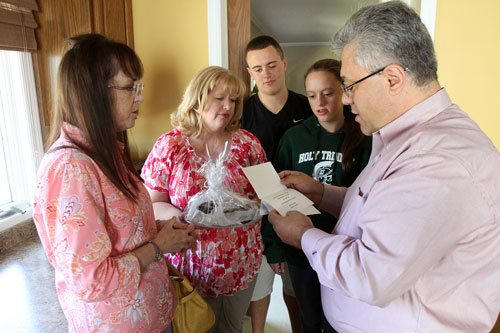Often after the death of the loved one of a friend, neighbor or co- worker, people are at a loss for what to say or do but they might be quick to whip up a batch of brownies or a chicken casserole.
And that’s the right thing – for the person who cooks it and the recipients – say those who have been there.
Noelle Hawton, parishioner at Nativity of Mary parish, Bloomington, Minn., said when she was unexpectedly widowed at the age of 28, she had her first experience with lots of food arriving at her doorstep.
“I had never lost anyone before and found it odd and surprising that neighbors I hadn’t even met yet, as well as co-workers, were sending me food,” she told Catholic News Service in an email.
What she also hadn’t expected was how her home would become a central location for family members as they made plans for her husband’s funeral and burial.
“That food was a godsend, as it allowed us all to eat without having to plan meals or hit the store, which none of us had the energy to do,” she said.
Hawton has been quick to return the favor, saying she always brings food to someone who has experienced a death in the family; but she also makes the point to “bring it over frozen in case they have lots of fresh food they will be working to get through.”
Easy to Transport, Eat
Sending a frozen meal is one tip among many that regular donors and bloggers suggest. Other suggestions include: trays of cut-up vegetables and fruit, bagels and cream cheese, sandwich trays, soups or stews, pies or casseroles. Ideally, food should be easy to transport and easy to eat. It should also hold well and freeze well.
Dr. Carole Lieberman, a psychiatrist and author based in Los Angeles, said “a lot of times, people have difficulty finding the right words to express their condolences, and a gift of food conveys their warm support.”
She also noted that while “the family may get more food than they or their sympathetic friends can eat, the gesture is what is important. Food is symbolic of nurturance, especially when the food is homemade. This conveys comfort to the grieving family.”
The way these good-intentioned foods are presented is also key. For example, donated meals should be given in containers that do not need to be returned. The food should also be labeled and include specific heating instructions. In other words: Do not put an extra burden on the receiver.
Another tip food givers should keep in mind is that they are very like- ly not the only ones with this idea. Donators should consider using web- sites that organize meals and drop-off schedules such as foodtidings.com or takethemameal.com.
These sites provide an online sign-up sheet for donated meals and post information such as food allergies and best times to drop off meals.

